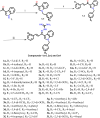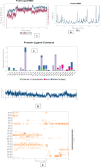Unveiling the potential of novel indol-3-yl-phenyl allylidene hydrazine carboximidamide derivatives as AChE/BACE 1 dual inhibitors: a combined in silico, synthesis and in vitro study
- PMID: 39081657
- PMCID: PMC11287240
- DOI: 10.1039/d4ra04315d
Unveiling the potential of novel indol-3-yl-phenyl allylidene hydrazine carboximidamide derivatives as AChE/BACE 1 dual inhibitors: a combined in silico, synthesis and in vitro study
Abstract
Considering the failure of many enzyme inhibitors for Alzheimer's disease (AD), research is now focused on multi-target directed drug discovery. In this paper, inhibition of two essential enzymes implicated in AD pathologies, acetylcholinesterase (AChE) and BACE 1 (Beta-site APP Cleaving Enzyme), has been explored. Taking clues from our previous work, 41 novel indol-3-yl phenyl allylidene hydrazine carboximidamide derivatives were synthesized. The results indicated that compounds inhibited both enzymes in micromolar concentrations. Compound 1l is proposed as the most active. In silico, it was seen to occupy the binding pocket of AChE and BACE 1. The ADME predictions showed that these compounds have acceptable physicochemical characteristics. This study provides new leads for the assessment of AChE and BACE 1 dual inhibition as a promising strategy for AD treatment.
This journal is © The Royal Society of Chemistry.
Conflict of interest statement
The authors declare that they have no known competing financial interests or personal relationships that could have appeared to influence the work reported in this paper.
Figures









Similar articles
-
Design, synthesis, in silico, and in vitro evaluation of pyrrol-2-yl-phenyl allylidene hydrazine carboximidamide derivatives as AChE/BACE 1 dual inhibitors.RSC Adv. 2024 Aug 23;14(37):26703-26722. doi: 10.1039/d4ra03589e. eCollection 2024 Aug 22. RSC Adv. 2024. PMID: 39184009 Free PMC article.
-
Dual Inhibitors of AChE and BACE-1 for Reducing Aβ in Alzheimer's Disease: From In Silico to In Vivo.Int J Mol Sci. 2022 Oct 28;23(21):13098. doi: 10.3390/ijms232113098. Int J Mol Sci. 2022. PMID: 36361906 Free PMC article.
-
Synthesis, In Silico and In Vitro Evaluation of Some Flavone Derivatives for Acetylcholinesterase and BACE-1 Inhibitory Activity.Molecules. 2020 Sep 5;25(18):4064. doi: 10.3390/molecules25184064. Molecules. 2020. PMID: 32899576 Free PMC article.
-
Dual-target compounds for Alzheimer's disease: Natural and synthetic AChE and BACE-1 dual-inhibitors and their structure-activity relationship (SAR).Eur J Med Chem. 2021 Oct 5;221:113492. doi: 10.1016/j.ejmech.2021.113492. Epub 2021 Apr 24. Eur J Med Chem. 2021. PMID: 33984802 Review.
-
Structural determinants of the multifunctional profile of dual binding site acetylcholinesterase inhibitors as anti-Alzheimer agents.Curr Pharm Des. 2010;16(25):2818-36. doi: 10.2174/138161210793176536. Curr Pharm Des. 2010. PMID: 20698824 Review.
Cited by
-
Multitarget Compounds Designed for Alzheimer, Parkinson, and Huntington Neurodegeneration Diseases.Pharmaceuticals (Basel). 2025 Jun 1;18(6):831. doi: 10.3390/ph18060831. Pharmaceuticals (Basel). 2025. PMID: 40573227 Free PMC article. Review.
References
-
- Sang Z. Wang K. Dong J. Tang L. Alzheimer's Disease: Updated Multi-targets Therapeutics Are in Clinical and in Progress. Eur. J. Med. Chem. 2022;238:114464. - PubMed
-
- https://www.who.int, accessed on 04-04-2024
-
- Luo Z. Sheng J. Sun Y. Lu C. Yan J. Liu A. Luo H.-b. Huang L. Li X. Synthesis and evaluation of multi-target-directed ligands against Alzheimer's disease based on the fusion of donepezil and ebselen. J. Med. Chem. 2013;56:9089–9099. - PubMed
-
- Srivastava P. Tripathi P. N. Sharma P. Shrivastava S. K. Design, Synthesis, and Evaluation of Novel N-(4-phenoxybenzyl)Aniline Derivatives Targeting Acetylcholinesterase, β-amyloid Aggregation and Oxidative Stress to Treat Alzheimer’S Disease. Bioorg. Med. Chem. 2019;27:3650–3662. - PubMed
LinkOut - more resources
Full Text Sources

